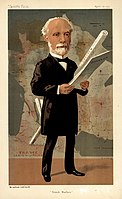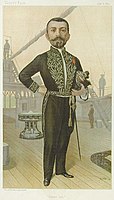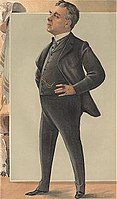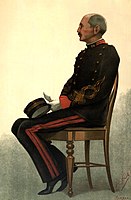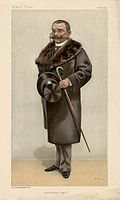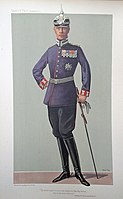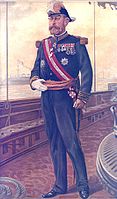Jean Baptiste Guth
Jean Baptiste Guth | |
|---|---|
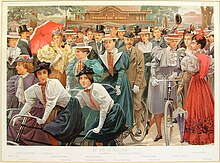 Au Bois de Boulogne by Guth, 1897 | |
| Born | 4 January 1855 Paris, France |
| Died | 1922 (aged 66–67) Paris, France |
| Nationality | French |
| Education | École des Beaux-Arts, Jean-Léon Gérôme |
| Known for | Portrait art, illustration |
Jean Baptiste Guth (4 January 1855 – 1922) was a French portrait artist, active from 1875 until a few months before his death.
Guth worked mostly in watercolour and pastels. Much of his work was as an illustrator of magazines, especially the French L'Illustration and the British Vanity Fair, for which he signed his name simply as GUTH.
Life and work
[edit]Born in Paris, in 1875 Guth was admitted as a student at the École des Beaux-Arts, where he was taught by Jean-Léon Gérôme. From 1882, perhaps recommended by Louis Charles Auguste Steinheil, he worked for Félix Gaudin, for whom he made drawings for stained glass windows.[1] In 1883, Guth moved to London.[2]

From 1884 to 1920, Guth's work was published in the French magazine L'Illustration[1] and from 1889 to 1909 in the British Vanity Fair, signing himself "GUTH". Among his many portraits for Vanity Fair were his images of Queen Victoria,[3] Anatole France,[4] and Alfred Dreyfus.[5] After the death of "Ape" in 1889, "Spy" and Guth were the only regular contributors to the magazine's weekly colour portrait feature.[6] The issue of 3 June 1897 included a double-page colour illustration by Guth, Au Bois de Boulogne, showing a fashionable crowd in the Bois de Boulogne park, Paris, including the Duke and Duchess of Rohan, the Prince and Princess of Broglie, the Duchess of Doudeauville, Cléo de Mérode, Liane de Pougy, Carolina Otéro, Princess Ghika, Ralouka Bibesco-Bassaraba de Brancovan, and Ernest Coquelin.[7][8]

Guth worked mostly in watercolour and pastels, for reproduction by chromolithography.[1]
Guth revealed few details of his own life. A book about Gérôme notes the existence of a portrait of him by Guth, in which Gérôme is shown wearing a sculptor's smock, working on a bust. The artist is described as "Jean-Baptiste Guth, peintre et élève de Gérôme, sur lequel on ne sait pas grand chose..." (painter and pupil of Gérôme, about whom not much is known).[9]
Exhibitions
[edit]In the final year of the First World War, the Goupil Gallery in London presented an exhibition of Guth's portraits of British and French generals, admirals, and statesmen,[10] under the title "Men who are running the War, and other celebrities of the Entente".[11] The Graphic said in its review "No finer series of war portraits has been seen in London than those of M. Jean Baptiste Guth, now on exhibition at the Goupil Gallery in Regent Street... They are drawn in chalk, and have all been taken from life. They are audacious in their conceptualization, unavoidably annexing the defining feature of the subject. One of the best is that of Viscount Grey. The French series, which includes Poincaré, Clemenceau, Pétain and Foch, is very interesting and more novel to the average Englishman."[12]
Gallery
[edit]-
Henri Blowitz, 1889
-
Gustave Eiffel, 1889
-
Charles de Freycinet 1891
-
Alphonse Daudet, 1893
-
Pierre Loti, 1895
-
Félix Faure, 1895
-
Marquis Li Hung Chang, 1896
-
Benoît-Constant Coquelin, 1898
-
Henri Brisson, 1898
-
Alfred Dreyfus, 1899
-
Jules-Albert de Dion, 1899
-
Victor, Prince Napoléon, 1899
-
Théophile Delcassé, 1899
-
Edmond Rostand, 1901
-
Vice-Admiral Caillard, 1905
-
Alfonso XIII of Spain, 1906
-
Anatole France, 1909
Notes
[edit]- ^ a b c Jean-François Luneau, Félix Gaudin, peintre-verrier et mosaïste, 1851–1930 (Presses Universitaires Blaise Pascal, Clermont Ferrand 2006, ISBN 978-2845162846), p. 406
- ^ Jean Paul Perrin, Guth, Jean Baptiste at lillustration.com, accessed 10 January 2019
- ^ Roy T. Matthews, Peter Mellini, In "Vanity Fair" (London: Scolar Press, 1982), p. 32
- ^ Anatole France by Guth on artnet.com
- ^ Matthews & Mellini (1982), p. 207
- ^ Richard Ormond, Vanity Fair: an exhibition of original cartoons (National Portrait Gallery, 1976), p. 12
- ^ Matthews & Mellini (1982), p. 238
- ^ Legend at foot of chromolithograph entitled "Au Bois de Boulogne" in Vanity Fair issue dated 3 June 1897
- ^ Jean-Léon Gérôme, 1824-1904: peintre, sculpteur et graveur : ses œuvres conservées dans les collections françaises publiques et privées (Musée de Vesoul, 1981), p. 174
- ^ Le Musée et l'encyclopédie de la guerre, Volume 3 (J. Grand-Carteret, 1918), p. 69: "Un artiste parisien, Jean-Baptiste Guth, élève de Gérome, et peintre décorateur, a exposé à la Goupil-Gallery, les portraits des hommes d'Etat, des généraux, des amiraux français et anglais qui dirigent et conduisent la guerre."
- ^ The Burlington Magazine for Connoisseurs, Volume 32 (London: Savile Publishing Company, 1918), p. 84
- ^ The Graphic dated 09 March 1918, p. 34
External links
[edit]- Jean Baptiste Guth (‘Guth’) at npg.org.uk (National Portrait Gallery, London)
- Jean Baptiste Guth at art.famsf.org (Fine Arts Museums of San Francisco)



